
 National Children’s Gardening Week is a wonderful annual event that’s designed to inspire children’s curiosity around growing plants and gardening-related activities. It takes place during what is typically a warm period of the year. That’s important because it means seeds and plants will grow faster and need minimal protective measures from inclement weather. Speedy growing results will appeal to little ones!
National Children’s Gardening Week is a wonderful annual event that’s designed to inspire children’s curiosity around growing plants and gardening-related activities. It takes place during what is typically a warm period of the year. That’s important because it means seeds and plants will grow faster and need minimal protective measures from inclement weather. Speedy growing results will appeal to little ones!
We encourage children large and small to get involved in the event, which begins later in May. At the time of writing, there is plenty of time to prepare if families want to source things like seeds, seed trays, and eco-friendly compost, and to find out about any related events in their neighbourhoods. Today’s guide explains more about the event, the reasons for it, the benefits of taking part, and the kinds of gardening-related activities little ones can take part in. National Children’s Gardening Week is always an incredibly worthwhile, educational, and fun week — so don’t miss out!
When is National Children’s Gardening Week 2025?
 National Children’s Gardening Week coincides perfectly with the Spring Bank Holiday and May half-term school holiday, taking place from the 24th of May to the 1st of June 2025. It’s usually a lovely warm week and is perfect timing for children to make the most of the event and to maximise the many benefits of spending time around nature.
National Children’s Gardening Week coincides perfectly with the Spring Bank Holiday and May half-term school holiday, taking place from the 24th of May to the 1st of June 2025. It’s usually a lovely warm week and is perfect timing for children to make the most of the event and to maximise the many benefits of spending time around nature.
“Children love growing plants and love being involved in the garden but they’re often impatient, wanting to see instant results. National Children’s Gardening Week aims to capture children’s enthusiasm at a time when results are immediate.” — Event Organiser.
Why Children Should Take Part in the Event
The organisers of the event put it perfectly:
“The aim of National Children’s Gardening Week is to inspire children’s curiosity, whilst the warm weather is a great time to see speedy results of seed sowing, planting and other gardening activities.”
The gardening-related activities also draw little ones closer to nature, which is well known to boost children’s health and mental well-being, improve learning, motor, and social skills, and much, much more. Learn more about the benefits of nature to children here.
 National Children’s Gardening Week also raises money to support children in hospices through the national charity Greenfingers. They create inspiring gardens and beautiful outdoor spaces where hospice children with life-limiting conditions can play, rest, relax, and spend time with family and friends. Such outdoor spaces allow affected children to spend quality time away from the bedside in well-designed outdoor areas where they can enjoy all the benefits of fresh air and a natural environment.
National Children’s Gardening Week also raises money to support children in hospices through the national charity Greenfingers. They create inspiring gardens and beautiful outdoor spaces where hospice children with life-limiting conditions can play, rest, relax, and spend time with family and friends. Such outdoor spaces allow affected children to spend quality time away from the bedside in well-designed outdoor areas where they can enjoy all the benefits of fresh air and a natural environment.
What Kind of Activities Can Children Take Part in?
 Children and families can take part at home as well as in participating schools, childcare settings, community groups, ‘outdoorsy’ retail outlets and even some National Trust properties.
Children and families can take part at home as well as in participating schools, childcare settings, community groups, ‘outdoorsy’ retail outlets and even some National Trust properties.
Commercial participant examples include places like formal gardens and garden centres. Such venues may lay on things like seed giveaways, bee hunts, bug hunts, garden treasure hunts, nature trails, recycled garden installations and lots of other activities to inspire gardening in children. They may include gardening-inspired activities like leaf printing, rock painting, plant colouring sheets, flower drawing competitions, vegetable planting classes, sunflower seed planting, and many more. Children will have lots to choose from, making for some seriously fun and inspiring trips during the week. Check out related activities in your local area in the run-up to the start of the event.
At home, there are a myriad of ways to take part in the event. Suggestions include:
 Sowing Wildflower Seeds
Sowing Wildflower Seeds
Sowing wildflower seeds can be super-easy for even the youngest children and, in fact, you can read our detailed children’s guide to growing wildflowers here. What’s more, pollinators like bees and butterflies will love the resulting flowers!
Growing Herbs
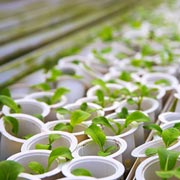 Herbs and some vegetables can be grown from seeds, cultivated, and harvested from simple flowerpots or yoghurt pots. They can also be ‘re-grown’ through various devious means that will fascinate children including under-fives. We wrote a whole post about that too, so take a look — it’s quite ingenious, is incredibly educational, and results in free food! What’s more, it can be done indoors. Learn more about how children can grow food at home, for free, here.
Herbs and some vegetables can be grown from seeds, cultivated, and harvested from simple flowerpots or yoghurt pots. They can also be ‘re-grown’ through various devious means that will fascinate children including under-fives. We wrote a whole post about that too, so take a look — it’s quite ingenious, is incredibly educational, and results in free food! What’s more, it can be done indoors. Learn more about how children can grow food at home, for free, here.
Grow Some ‘Egg Heads’ with Cress Seeds
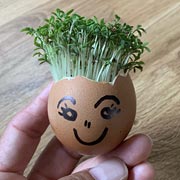 Another ‘indoor gardening’ activity is growing these comical ‘egg heads’. Grown simply from cress seeds, they can be grown in egg shells as shown, or another alternative would be yoghurt pots. When the cress is ready to be harvested and used in salads or as a garnish, the little characters can have a haircut! Here’s our guide that explains what to do.
Another ‘indoor gardening’ activity is growing these comical ‘egg heads’. Grown simply from cress seeds, they can be grown in egg shells as shown, or another alternative would be yoghurt pots. When the cress is ready to be harvested and used in salads or as a garnish, the little characters can have a haircut! Here’s our guide that explains what to do.
Bee-Friendly Gardening
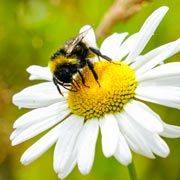 Another activity that children can get involved in for National Children’s Gardening Week is to create bee-friendly gardens. Our recent post about World Bee Day explains how to make a bee oasis (from where bees and pollinators can get a refreshing drink) and a bee-friendly garden. Check out those and some other bee-friendly activities here.
Another activity that children can get involved in for National Children’s Gardening Week is to create bee-friendly gardens. Our recent post about World Bee Day explains how to make a bee oasis (from where bees and pollinators can get a refreshing drink) and a bee-friendly garden. Check out those and some other bee-friendly activities here.
Make Free Compost
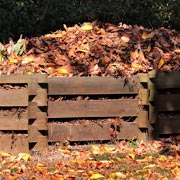 Plants love compost and so do minibeasts. So, another wonderful activity for children in National Children’s Gardening Week is to make homemade compost. Our dedicated guide to composting for kids explains everything children need to do for this hugely worthwhile, ecologically sound, and educational activity.
Plants love compost and so do minibeasts. So, another wonderful activity for children in National Children’s Gardening Week is to make homemade compost. Our dedicated guide to composting for kids explains everything children need to do for this hugely worthwhile, ecologically sound, and educational activity.
Flower Pressing
 Once the flowers are blooming outside, children can experiment with pressing flowers. Pressed flowers are a wonderful way for children to save flowers semi-permanently as keepsakes or to use as part of an art activity.
Once the flowers are blooming outside, children can experiment with pressing flowers. Pressed flowers are a wonderful way for children to save flowers semi-permanently as keepsakes or to use as part of an art activity.
TIP: highly-coloured flowers work best and smaller ones are also likely to flatten more easily and dry more quickly.
Once picked, flowers can be placed, ideally so they don’t overlap, between absorbent paper like newsprint, blotting paper, or tissue paper. Place this between the pages of a thick book or sketch pad that has an extra weight on top. Leave somewhere dry for a couple of weeks or so and they will flatten and dry, ready for use as a bookmark or as part of a creative art piece.
Make a Magical Fairy Garden
 The youngest children will love this activity! Children will need some scavenged moss, pebbles, sticks, seashells and perhaps small pieces of driftwood from a beach. Children can then use these to transform the soil in a large pot or on top of a log into a whimsical and magical-looking fairy garden. Children can let their imaginations run riot and create things like a fairy house made of sticks and driftwood, fairy lawns made of moss, and garden paths made with pebbles that form stepping stones. They could even include a fairy pond made with a small mirror, tin foil that covers the discarded lid of a jar, or real water in a mini flowerpot drip tray. Such fairy gardens can look truly magical!
The youngest children will love this activity! Children will need some scavenged moss, pebbles, sticks, seashells and perhaps small pieces of driftwood from a beach. Children can then use these to transform the soil in a large pot or on top of a log into a whimsical and magical-looking fairy garden. Children can let their imaginations run riot and create things like a fairy house made of sticks and driftwood, fairy lawns made of moss, and garden paths made with pebbles that form stepping stones. They could even include a fairy pond made with a small mirror, tin foil that covers the discarded lid of a jar, or real water in a mini flowerpot drip tray. Such fairy gardens can look truly magical!
The Activity Ideas are Endless!
We’ve highlighted just a handful of activity ideas that will fascinate, enthral and educate children this National Children’s Gardening Week. However, we’ve only scratched the surface and many more activities are possible with a bit of imagination. To give you some more ideas, check out these gardening-related activities for children and some eco-friendly gardening activities for kids here. Whatever activity they take part in, we wish every child a very enjoyable, fulfilling, and educational gardening week!
Little Cedars Day Nursery
the Natural Childcare Choice for Streatham Families

 Families can rest assured that children at Little Cedars Nursery in Streatham get ample opportunities to be around nature. The setting has outdoor areas where children can grow plants, flowers, fruit and vegetables. Doing so is something that they love and learn so much from. It teaches them new skills, hones motor skills, helps them develop a sense of responsibility and empathy, and teaches them about the world they live in. It’s just one small part of the comprehensive early years education they receive at Little Cedars Nursery. Here, we do everything we can to help them become the best versions of themselves. We give them the very best start in life, enabling them to be ready to thrive from the moment they leave us to begin school. If you’re interested in your child joining Little Cedars, please choose a contact option below to get started.
Families can rest assured that children at Little Cedars Nursery in Streatham get ample opportunities to be around nature. The setting has outdoor areas where children can grow plants, flowers, fruit and vegetables. Doing so is something that they love and learn so much from. It teaches them new skills, hones motor skills, helps them develop a sense of responsibility and empathy, and teaches them about the world they live in. It’s just one small part of the comprehensive early years education they receive at Little Cedars Nursery. Here, we do everything we can to help them become the best versions of themselves. We give them the very best start in life, enabling them to be ready to thrive from the moment they leave us to begin school. If you’re interested in your child joining Little Cedars, please choose a contact option below to get started.
Get started on your child’s nursery application today, arrange a guided tour, or ask a question:
Little Cedars Nursery is a ‘Good Provider’ and supports childcare funding for eligible children and babies from just 9 months of age. The nursery is in Streatham close to Tooting Common, Tooting, Furzedown, Balham, Norbury and Colliers Wood.
For the sake of their safety and well-being, young children should be supervised, and activities should be overseen by an adult whenever appropriate, especially outdoors.

 Sowing Wildflower Seeds
Sowing Wildflower Seeds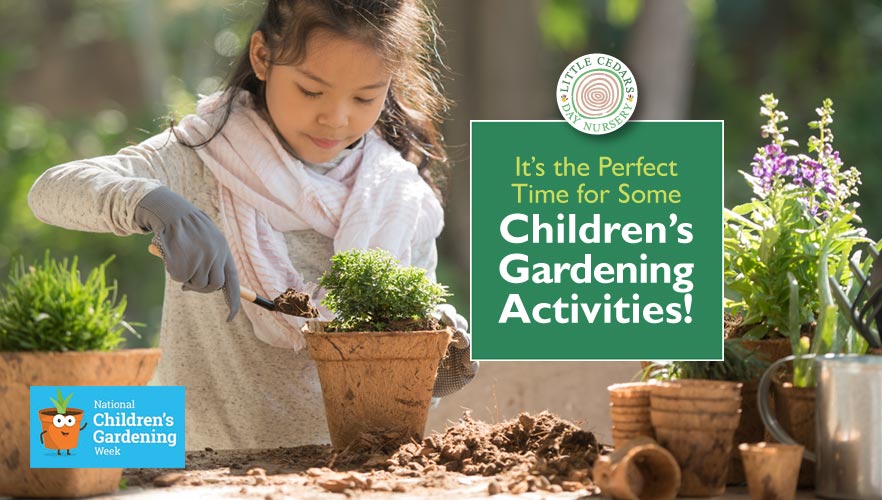
 National Children’s Gardening Week takes place each year in the UK during what’s known as the ‘warm week’ beginning right at the end of May. This year (2024) it spans from 25 May to 2 June. However, children can get involved in gardening well outside of those dates*, of course.
National Children’s Gardening Week takes place each year in the UK during what’s known as the ‘warm week’ beginning right at the end of May. This year (2024) it spans from 25 May to 2 June. However, children can get involved in gardening well outside of those dates*, of course. This year (2024), National Children’s Gardening Week has teamed up with The World of Peter Rabbit and is encouraging children and their families to Grow With Peter Rabbit!
This year (2024), National Children’s Gardening Week has teamed up with The World of Peter Rabbit and is encouraging children and their families to Grow With Peter Rabbit! 
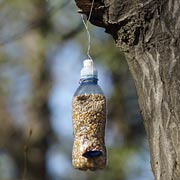 Did you know, there are some incredibly
Did you know, there are some incredibly 
 Compost heaps are also wonderful homes for minibeasts, which are also fun and educational for children to spot. Use our previously published
Compost heaps are also wonderful homes for minibeasts, which are also fun and educational for children to spot. Use our previously published 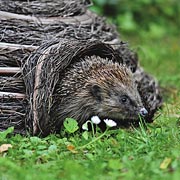 So, making a wildlife-friendly garden or area is a very worthwhile activity for children to take part in — and is educational on so many levels. See
So, making a wildlife-friendly garden or area is a very worthwhile activity for children to take part in — and is educational on so many levels. See  The benefits of gardening for children are many and varied and that’s why it’s such a wonderful activity to get them involved in. It will teach children many new skills and new knowledge. It’ll teach them about the circle of life, how to care and be responsible for other living things, and about the importance of looking after the planet. It will also give them an insight into where some food types come from. It is also great fun, will give children a huge sense of achievement, and may even open their eyes to the possibility of careers in horticulture, land management, food production, farming, and the like. And, of course, gardening makes the world a better place in so many ways. Let’s also not forget that
The benefits of gardening for children are many and varied and that’s why it’s such a wonderful activity to get them involved in. It will teach children many new skills and new knowledge. It’ll teach them about the circle of life, how to care and be responsible for other living things, and about the importance of looking after the planet. It will also give them an insight into where some food types come from. It is also great fun, will give children a huge sense of achievement, and may even open their eyes to the possibility of careers in horticulture, land management, food production, farming, and the like. And, of course, gardening makes the world a better place in so many ways. Let’s also not forget that 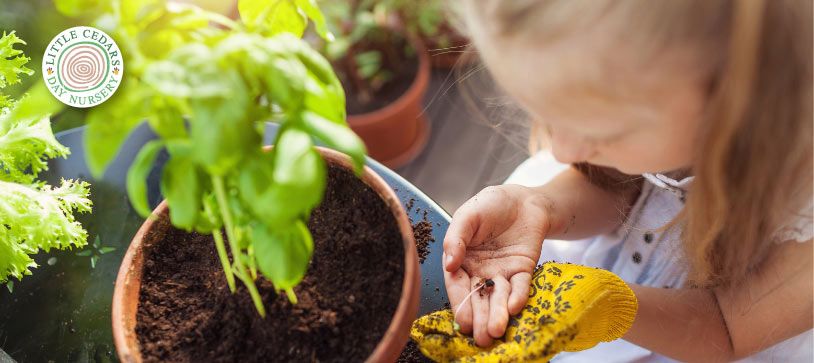
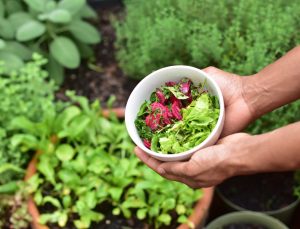 It may surprise some to learn that you can buy some vegetables and herbs just once and never have to buy them again. The secret is knowing which, and how to re-grow them. It turns out that it’s pretty easy, so we encourage parents to help youngsters get started. Once they see growing shoots or roots and, later, vegetables or herbs that the family can actually eat, they’ll be so pleased that they made this little miracle possible. What’s more, it will have taught them something about where food comes from, how to grow it sustainably and how to look after the living plants. If you’re really lucky, it may even encourage them to take things a step further and get involved in food preparation and cooking later on. It’s amazing, actually, where such a simple, fun, activity can lead!
It may surprise some to learn that you can buy some vegetables and herbs just once and never have to buy them again. The secret is knowing which, and how to re-grow them. It turns out that it’s pretty easy, so we encourage parents to help youngsters get started. Once they see growing shoots or roots and, later, vegetables or herbs that the family can actually eat, they’ll be so pleased that they made this little miracle possible. What’s more, it will have taught them something about where food comes from, how to grow it sustainably and how to look after the living plants. If you’re really lucky, it may even encourage them to take things a step further and get involved in food preparation and cooking later on. It’s amazing, actually, where such a simple, fun, activity can lead! It’s possible, and indeed fairly easy, to grow your own produce even without a garden. So long as you look after your plants and give them water, soil and light as a bare minimum, they will grow. If you don’t have a garden, perhaps you have a small courtyard or patio where you can grow in containers. If you don’t have any outside areas at all, you can grow in flower pots and other containers on window sills, balconies, under skylights and so on. This makes growing produce possible almost anywhere, including in urban London in high-rise flats. After all, it’s in a plant’s nature to want to grow.
It’s possible, and indeed fairly easy, to grow your own produce even without a garden. So long as you look after your plants and give them water, soil and light as a bare minimum, they will grow. If you don’t have a garden, perhaps you have a small courtyard or patio where you can grow in containers. If you don’t have any outside areas at all, you can grow in flower pots and other containers on window sills, balconies, under skylights and so on. This makes growing produce possible almost anywhere, including in urban London in high-rise flats. After all, it’s in a plant’s nature to want to grow.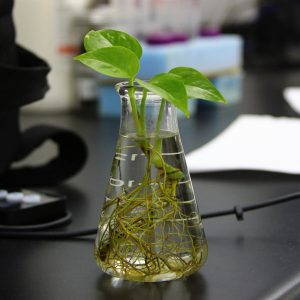 Children could start with green onions or spring onions. These are particularly easy to ‘re-grow’. Later, perhaps, the children can apply the same approach to celery, lemon grass, Cos lettuce and Pak Choy (a type of Chinese cabbage). Simply save an inch or so thick section of your shop-bought root vegetables (perhaps the last you will ever need to buy), which includes the bottom part at the root end. All your children need to do is to place that section, root end downwards, in a glass of water. Leave them in the water and, after somewhere between 1 and 3 weeks, roots will start growing. Children will love monitoring this process each day and they will enjoy looking after and caring for a living thing. Once the roots are substantial enough, children can take them out of the glass and re-pot them in soil, ideally with a bit of compost if you have any. This can be in containers, appropriately sized flower pots or in the garden if you have access to one. Before long, your plants will give your children more, free herbs and vegetables that you can all enjoy.
Children could start with green onions or spring onions. These are particularly easy to ‘re-grow’. Later, perhaps, the children can apply the same approach to celery, lemon grass, Cos lettuce and Pak Choy (a type of Chinese cabbage). Simply save an inch or so thick section of your shop-bought root vegetables (perhaps the last you will ever need to buy), which includes the bottom part at the root end. All your children need to do is to place that section, root end downwards, in a glass of water. Leave them in the water and, after somewhere between 1 and 3 weeks, roots will start growing. Children will love monitoring this process each day and they will enjoy looking after and caring for a living thing. Once the roots are substantial enough, children can take them out of the glass and re-pot them in soil, ideally with a bit of compost if you have any. This can be in containers, appropriately sized flower pots or in the garden if you have access to one. Before long, your plants will give your children more, free herbs and vegetables that you can all enjoy.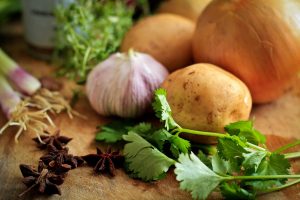 Garlic cloves are also incredibly easy to regrow in a similar way. Perhaps at some point you’ve unintentionally allowed your shop-bought garlic cloves to ‘sprout’. Well, that’s how to start off. Rather than discarding them, your children can put them in water and allow roots to grow. Then, they should plant them out in soil and eventually they’ll end up with more, free, garlic cloves. What’s more, they will tend to taste more mild and delicate than shop-bought garlic — children will probably appreciate that. It’s the same with ginger roots, but allow months rather than weeks in their case.
Garlic cloves are also incredibly easy to regrow in a similar way. Perhaps at some point you’ve unintentionally allowed your shop-bought garlic cloves to ‘sprout’. Well, that’s how to start off. Rather than discarding them, your children can put them in water and allow roots to grow. Then, they should plant them out in soil and eventually they’ll end up with more, free, garlic cloves. What’s more, they will tend to taste more mild and delicate than shop-bought garlic — children will probably appreciate that. It’s the same with ginger roots, but allow months rather than weeks in their case.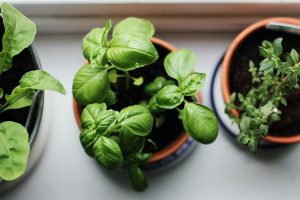 Herbs like Coriander, Rosemary and Basil can also be re-grown. Children can simply take scraps or clippings (4 inches long in the case of basil, 2-3 inches in the case of Rosemary) and place them in glasses of water in a well-lit spot on the windowsill. Once they have sprouted roots of about 2 or so inches long, these young ‘plants’ can be transplanted into soil or compost in pots. Your child will then be able to watch the plants flourish and grow into new herbs that can be harvested for food later on. The children will also soon discover that each of these herbs has a wonderful and distinctive taste and smell.
Herbs like Coriander, Rosemary and Basil can also be re-grown. Children can simply take scraps or clippings (4 inches long in the case of basil, 2-3 inches in the case of Rosemary) and place them in glasses of water in a well-lit spot on the windowsill. Once they have sprouted roots of about 2 or so inches long, these young ‘plants’ can be transplanted into soil or compost in pots. Your child will then be able to watch the plants flourish and grow into new herbs that can be harvested for food later on. The children will also soon discover that each of these herbs has a wonderful and distinctive taste and smell. Later, when growing sprouts reach the surface, the child should keep those covered with soil (this is called ‘hilling’). Get your child to keep the soil moist but not over-saturated over the subsequent weeks. If planted in the spring, your children should be able to harvest potatoes in the summer.
Later, when growing sprouts reach the surface, the child should keep those covered with soil (this is called ‘hilling’). Get your child to keep the soil moist but not over-saturated over the subsequent weeks. If planted in the spring, your children should be able to harvest potatoes in the summer. Then, of course, your children can also experiment with nursery bought, or mail order seeds. Although not free, they’re reasonably inexpensive and also fun for children to grow if you follow the instructions and timing suggested on the seed packets. Beans of various kinds and sugar snaps are particularly easy to grow and usually result in an excellent crop. They will benefit from being in a garden or outdoor patio area, ideally, due to the space they require. They will need more vertical space than horizontal space, however, so even balcony planting may be possible if you have suitable grow bags.
Then, of course, your children can also experiment with nursery bought, or mail order seeds. Although not free, they’re reasonably inexpensive and also fun for children to grow if you follow the instructions and timing suggested on the seed packets. Beans of various kinds and sugar snaps are particularly easy to grow and usually result in an excellent crop. They will benefit from being in a garden or outdoor patio area, ideally, due to the space they require. They will need more vertical space than horizontal space, however, so even balcony planting may be possible if you have suitable grow bags.
